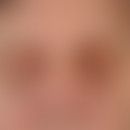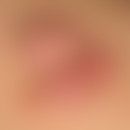Synonym(s)
DefinitionThis section has been translated automatically.
Rare tumor originating from myofibroblasts with larger amounts of collagen fibers. S.a. leiomyoma. Adult myofibroma is the analogue of infantile myofibromatosis.
EtiopathogenesisThis section has been translated automatically.
You might also be interested in
ManifestationThis section has been translated automatically.
Occurs in young adults between 20 and 30 years of age. Women and men are affected in the ratio 8:1. The tumour occurs less frequently in children.
LocalizationThis section has been translated automatically.
Mainly shoulder region, more rarely upper extremity or trunk; also palmar and plantar.
ClinicThis section has been translated automatically.
1-2 cm large, roundish to oval, skin-colored or reddish-brown plaque-like or also calotte-shaped raised tumor (possibly with central crust) with peripheral border wall and surrounding telangiectasia; reminiscent of a basal cell carcinoma.
HistologyThis section has been translated automatically.
In the reticular dermis, tumour clusters which are separated from the epidermis, are blurred and usually biphasic. Areas of bundles of spindle-shaped cells rich in cytoplasm; next to them areas of irregularly arranged, small, low-cytoplasmic cells with hyperchromatic nuclei. Capillary vessels are incised in varying numbers. Histological subtypes:
- leiomyoma type (predominance of fascicular parts)
- Cell-rich spindle cell type (fascicular or mat-like intertwined small spindle cells)
- Hemangiopericytoma or glomus type (predominance of small myoid, pericyte or glomoid cells)
- Biphasic type (see above)
- Immunohistology: Tumor cells are vimentin- and alpha-SMA positive and desmin- and FXIIIa negative.
Differential diagnosisThis section has been translated automatically.
- Clinical signs: scars; keloids; dermatofibrosarcoma protuberans (CD 34 positive cells).
- Histological: Dermatofibrosarcoma protuberans; Hemangiopericytoma; Leiomyoma.
TherapyThis section has been translated automatically.
Progression/forecastThis section has been translated automatically.
Note(s)This section has been translated automatically.
LiteratureThis section has been translated automatically.
- Guitart J et al (1996) Solitary cutaneous myofibromas in adults: report of six cases and discussion of differential diagnosis. J Cutan Pathol 23: 437-444
- Hill H (1993) Plaque-like dermal fibromatosis/dermatomyofibroma. J Cutan catheter 20: 94
- Kamino H et al (1992) Dermatomyofibroma. A benign cutaneous, plaque-like proliferation of fibroblasts and myofibroblasts in young adults. J Cutan Pathol 19: 85-93
- Laaff H et al (1990) Cutaneous myofibroma - late manifestation. Dermatologist 41: 617-619
- Martinez-Mir A et al (2003) Germline fumarate hydratase mutations in families with multiple cutaneous and uterine leiomyomata. J Invest Dermatol 121: 741-744
- Sim JH et al (2011) Development of dermatomyofibroma in a male infant. Ann Dermatol 23 Suppl 1: S72-74.
- Tardío JC et al (2011) Dermatomyofibromas presenting in pediatric patients: clinicopathologic characteristics and differential diagnosis. J Cutan Pathol 38: 967-972
- Trotter MJ et al (1996) Linear dermatomyofibroma. Clin Exp Dermatol 21: 307-30
Incoming links (5)
Desmin; Fibroelastic connective tissue nevus; Hemangiopericytoma; Myofibroma, dermal (adult); Myofibromatosis infantile;Outgoing links (9)
Basal cell carcinoma (overview); Dermatofibrosarcoma protuberans (overview); Excision; Hamartom; Hemangiopericytoma; Keloid (overview); Leiomyoma (overview); Scar; Teleangiectasia;Disclaimer
Please ask your physician for a reliable diagnosis. This website is only meant as a reference.




